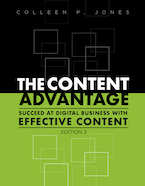
A content operation is all about the execution of your content vision and strategy.
Content Science defines content operations as the behind-the-scenes work of managing content activities as effectively and efficiently as possible. Your content operation either already has or will need to have a mix of elements involving people, process, and technology.
In today’s highly competitive content landscape, the demands on content teams are greater than ever. To be able to sustain and scale effective content, you have to develop what we call mature content operations.
The Content Science content operations maturity model consists of five levels:
- Chaotic: No formal content operations, only ad hoc approaches
- Piloting: Trying content operations in certain areas, such as for a blog
- Scaling: Expanding formal content operations across business functions
- Sustaining: Solidifying and optimizing content operations across business functions
- Thriving: Sustaining while also innovating and seeing return on investment
In Content Science’s study of content operations, 58 percent of participants reported that their companies were at level 1 or 2, while only 2 percent of participants reported their companies at level 5. So if you’re just starting out, don’t worry, you’re not alone. Developing a thriving content operation takes time, resources, and dedication.
This article walks through how you can start building and working toward a thriving content operation.
Make Content a Core Competency
Every company will need content as a core competency. And that competency will frequently cut across business functions, similar to the way competencies like information technology/engineering and design are crucial across business functions such as product, sales, marketing, and support. If a company does not elevate content to a cohesive core competency, then the company is likely to suffer problems that make content ineffective and that make its operations inefficient at scale.
To make content a core competency at your company, consider:
Hiring a chief content officer or executive soon: It will be impossible to mature content operations at your company to levels 4 or 5 without the right leadership. If you or your company are serious about content, hire a chief content officer or similar executive role early because it is the most effective and efficient approach to maturing operations. Once hired, this role can establish vision and strategy and then align and optimize teams, processes, and technologies.
Empowering content coaches and advocates: Mature content operations need more than executive leadership. They need managers, team leaders, or project leaders who are empowered to coach their teams on content issues. And just about everyone on the team must be prepared to advocate for content. Content operations mature more smoothly when each member of the content team is equipped to lead.
Evaluate effective competitor strategies: Competitors can be just as good a source of inspiration for content strategies as any textbook, consultant, or webinar. How are they conducting SEO optimization? What kind of content are they producing? What audiences are they capturing that your organization isn’t?
Creating a center for content excellence: To ensure everyone in your organization understands what it takes to create effective content, you need a go-to place to:
- Capture key lessons learned about your content so you don’t needlessly repeat tests or analyses.
- Summarize new outside research about content to save your teams research time and to spur ideas for optimizing or innovating content.
- Crystallize best practices to help your company maintain a high standard of content.
- Find training resources that can support discussions or briefings with stakeholders.
Get the Right People on Your Content Team
Getting the right leader in place is just one part of putting together a thriving content team. You also need to think about:
Cultivating a culture system: Culture is the often-overlooked but powerful connective tissue in content operations. Positive culture forms a level of trust that reduces the need for documenting and implementing pedantic rules and excessive reviews. Culture also makes governance infinitely smoother.
Putting together a star constellation: Your content operations will not be sustainable or scalable if they depend on one content rock star. That star will flame out quickly. Instead, you need to assemble a constellation of stars who, together, can make your content operations shine. In our “What Makes Content Teams Thrive?” study, we asked content leaders about the qualities they look for in hiring new team members. Top answers included:
- High performing
- Curious
- Systems thinking
- Considerate
- Competent in a content skill or role
Hiring for new roles: Just hiring a writer/editor (or dozens of writer/editors) will probably not give you the capabilities you need. Consider hiring people who can take on a variety of content jobs, including these five emerging roles:
- Content strategist: Identifies key content opportunities and conducts high-level planning
- Content analyst: Establishes or refines content intelligence systems and conducts analyses or evaluations
- Content engineer: Models content and architect rules to enable dynamic, automated content delivery and management
- Content designer: Plans and develops the content for specific experiences, especially dynamic experiences and conversational interfaces
- Content marketer: Plans and coordinates editorial and production for marketing
Empower Analysis and Evaluate Performance
One of our studies found that companies with maturing content operations were more likely to have at least some elements of content intelligence, even if they didn’t yet have an entire system.
To help your content operation succeed, you need to start:
Enabling content genius with data access: While they might not call it content genius, companies that are maturing in their content approach are empowering their teams to evaluate their content decisions. And while analytics are not all you need to make a content decision, they certainly help. A company that forces its content team to make decisions without data will never mature its content operations.
Dedicating effort to innovation: Mature companies devote ongoing effort to larger-scale experimentation—in other words, to researching and considering bigger bets on content.
Invest in Content Technology
It’s an exciting time for content technology. As the content landscape becomes more competitive, more organizations are developing specialized tools purpose-built to streamline content processes and enable creators to produce effective content.
To give your content operations a competitive boost, consider adopting these types of content technologies:
Content management systems (CMS): Content management is one of the most crucial elements of an effective content operation. With the staggering number of platforms to publish content on, managing your content processes can be a significant hurdle to achieving the next level of content maturity. The good news is that there are many CMS options available for content professionals. Whether it’s traditional or headless, CMS tools are an invaluable part of building a content operation.
Writing assistance tools: This is a highly diversified field of content technology. These tools help your creators align text with your content goals and evaluate elements like grammar, spelling, structure, and passive/active voice. Additionally, many writing assistance tools have begun incorporating AI elements into their platforms. With so many different tools, it’s all but guaranteed your organization can find at least one to suit your needs.
Content analytics tools: Part of developing effective content is learning what does and doesn’t work. To do this, mature organizations invest in appropriate content analytics tools. This family of tools evaluates how consumers interact with your content to help you make informed decisions when developing or executing your content strategy.
Moving Forward
Now that you have an understanding of what a content operation is and how to start building yours, you’re ready to take the next steps. Here are some suggestions for how to go from idea to full implementation with help from Content Science:
Assess your content operations: Want to assess your company’s level of content operations maturity? Is your organization chaotic, piloting, scaling, sustaining, or thriving? Take the Content Operations Assessment online at content-science.com/contentops to get a free quick assessment and a free copy of Content Science’s latest content operations study.
Dig in deeper with a certification course: This article features content from Content Science’s Content Leadership Certification program, which is part of our Content Science Academy. The certification course provides an introduction to content leadership, and covers topics including cultivating a content vision, bridging silos and aligning content stakeholders, and content leadership and operations research.
Get guidance from The Content Advantage: There are even more content operations insights and examples in The Content Advantage. You can use the information in the book to help you continue to develop your content operations.
Partner with Content Science: We are here to help you. If your organization is ready to get to work building a powerful content operation, you can engage Content Science to work with you and your team to develop a strategy that will put you on the path to success.
This article is part of our ongoing How To series, in which we help you learn how to get started in or improve across key content areas. Catch up with more in this series:
Events, Resources, + More
The Ultimate Guide to End-to-End Content
Discover why + how an end-to-end approach is critical in the age of AI with this comprehensive white paper.
The Content Advantage Book
The much-anticipated third edition of the highly rated book by Colleen Jones is available at book retailers worldwide. Learn more!
20 Signs of a Content Problem in a High-Stakes Initiative
Use this white paper to diagnose the problem so you can achieve the right solution faster.
Upskill with Content Science Academy
Training for modern content roles through on-demand certifications + courses or live workshops.






Comments
We invite you to share your perspective in a constructive way. To comment, please sign in or register. Our moderating team will review all comments and may edit them for clarity. Our team also may delete comments that are off-topic or disrespectful. All postings become the property of
Content Science Review.